 |
|
 |
Nihonbashi Odenma-cho is derived from "Tenma", the houseback relay delivery by horses system in the Edo Era. There were a number of merchants in the town, cotton wholesalers in the Edo Era, and textile wholesalers after the World War II. Consequently, the town was prospered. We interviewed maestro. Katsutoshi Hamada was the 12th owner of "Edo-ya". Edo-ya was producing and selling hake and many brushes at Edo Shogunate in about 300 years in the town. |
 |
 |
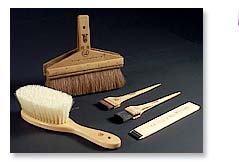
|
| The Store and its history |
 |
 |
|
A founder was first trained in Kyoto, and then he or she started to craft hake makeup brushes for ladies. Also, he or she designed painting brush for the personal painters of the Shogun within the inner place of the Edo Shogunate. The Shogun family gave their shop a name "Edo-ya" in 1718, and they have been in business for about 300 years since then. After Meiji Era, they started to make western brushes to fit the lifestyle changes.
Their products were over 3000 kinds from painting brushes for hang scrolls, sliding screen, lacquer wares, dye goods, cleaning brushes for pipes, bottles, bullet trains, and cars or brushes for makeup, clothes, body, tooth, hair, shoes and so on. Due to the variety of their products, their customers are also variety from amateur to professionals.
|
|
|
 |
| Serving the area for 12 generations |
 |
I was born in Odenma-cho in 1943. Except for the period I was evacuating during the Pacific War, I have been living in this town whole my life. I inherited this shop naturally since I have been told that our shop has a long history and so on. My father died young age, so the shop was run by my grand-mother until I became the owner.
Current house was rebuilt after the Great Kanto Earthquake, it was almost taken over by someone since the land cost rose enormously during the bubble economy, but we kept the house promised faithful business at all costs. I also inherited the principle to make high quality products until today.
|
|
|
 |
| raditional "Teue" process |
 |
The most traditional way of crafting a brush is called "Teue", that is to put in natural hair of pig, horse, goat, or wild boar into each hole of the brush. The technique were used in beard of the old man for Noh masks or sheath of spear carried in Daimyo's processions well.
Especially, It takes careful process to make finest quality clothes brush, sort hair into similar types, trim, chamfer the corner, and put into the holes. Maestro. Saburo Tanaka, who has 50 years of experience as a brush craftsman, shows "Teue" process, the finest pig hair clothes brush.
|
|
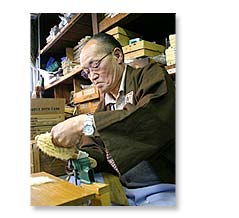 |
 |
 |
 |
 |
 |
 |
| |
|
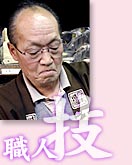
"Uekomi" process
First, he picks a wisp of pig hairs, folds them in the middle, hitches it to a stainless wire called "Hiki-sen", which was set through the hole in advance, pulls the wire, and fixes the hair. He fixes all the wisps and adjusts the hair to be same length. Make sure all wisps have same volume and length. It needs to be fold it while he does this over 120 - 130 holes per brush. After setting all the wisps of pig hair, he cuts the hiki-sen stainless wire, ties the ends in the back, beats the knots with a hammer. Finally, a fine handmade clothes brush is finished after covering the body.
Uekomi requires sensitive and delicate process; this can be done only by experienced craftsman using his fingertips and hands without machine operations.
As people said "Once used it, no one can use another brush", our product quality is supported by the faith and technique of our craftsman. I believe in concentrating on business in this shop than setting up another brunch office, keeping our product quality by appreciating 100 of craftsman working for us, foster successors.
|
|
|
 |
 |
 |
 |
 |
 |
|
 |
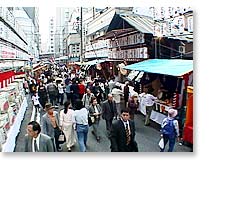
|
| Within the local community |
 |
 |
|
Aside from my main business, I am a chairman of preserving a "Bettara Ichi festivals" of Nihonbashi region. The festival is celebrated on October 19 and 20 at the Takarada Ebisu Shrine every year. "Bettara Ichi" has a long history. As a part of local educating activity, I have elementary school children draw or compose about Bettara festival, give prize to them. Also, it gives children opportunity to experience making brushes at our shop.
Odenma-cho used to be prosperous as it was recorded in Hiroshige Ando's famous wood block printing. There are used to be number of dye goods stores that our products were professionally used. I keep my best to inherit our traditional techniques by faithful work, and also do our best to develop to meet the 21st century lifestyle, with cooperation of my son.
|
|
|
|
 |
 |
 |
 |
| |
 |
|
 |
Edo-ya corporation
Produces and sells various kinds of brushes up to 3000 kinds for all use. Body brush (3,000 - 4,800 yen), Clothes brush (3,000 - 15,000 yen), hair brush (1,800 - 15,000 yen), makeup brush, toothbrush are available in various materials and qualities. For professional use, painting brush, cleaning brush (bullet train or car), delicate one for semiconductor is also available. Feel free to visit their Showa Era built wooden house. *Tax exclusive prices. |
 |
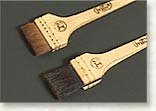 Address: 2-16 Odenma-cho Nihonbashi, Chuo-ku Address: 2-16 Odenma-cho Nihonbashi, Chuo-ku
Phone: 03-3664-5671
FAX: 03-3664-5674
URL:http://www.nihonbashi-edoya.co.jp
Office hours: 9:00-17:00 (Closed on Saturday, Sunday and holidays)
Access: Kodenma-cho (Hibiya line) or Shin Nihonbashi (JR Sobu line) |
|
|
 |
 |
 |
|
 |
|
 |